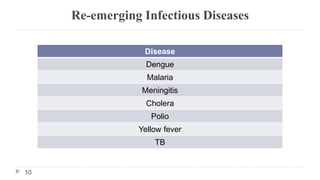Emerging and re-emerging diseases
- 1. Emerging and Re-emerging Infectious Diseases 1 Presented By- MD.Atikur Rahman
- 2. ’ü▒ Outline 2 ’üĮ Introduction ’üĮ Emerging & Re-emerging Disease ’üĮ Disease (Basic)
- 3. ’ü▒Emerging & Re-emerging disease 3 ’üĮ Emerging- Newly identified & previously unknown infectious agent that cause public health problems either locally or internationally. ’üĮ Re-emerging- Disease that once were major health problems globally in a particular country and then declined dramatically but are again becoming health problems for a significant proportions of the population.
- 4. Factors Contributing To Emergence 4 ’üĮ Agent ’üĮ Host ’üĮ Environment
- 7. 7
- 8. 8
- 9. Emerging Infectious Diseases 9 Disease Year recognized Ebola virus 1976 HIV/AIDS 1983 Hepatitis C 1989 Nipah Virus 1999 SARS 2003 H1N1 Flu 2009 Chikungunya 2013 Zika 2015
- 10. Re-emerging Infectious Diseases 10 Disease Dengue Malaria Meningitis Cholera Polio Yellow fever TB
- 11. Chikungunya 11 ’üĮ Prior to 2013, chikungunya virus cases and outbreaks had been identified in countries in Africa, Asia, Europe, and the Indian and Pacific Oceans. ’üĮ Chikungunya is an infection caused by the chikungunya virus (CHIKV). ’üĮ Symptoms ’üĮ Headache, fever, joint pain & swelling,
- 12. Zika Virus 12 ’üĮ Zika is spread mostly by the bite of an infected Aedes species mosquito (Ae. aegypti and Ae. albopictus). These mosquitoes bite during the day and night. ’üĮ Zika can be passed from a pregnant woman to her fetus. Infection during pregnancy can cause certain birth defects. ’üĮ Prevent Zika by avoiding mosquito bites.
- 13. Zika Virus 13 ’üĮ Zika primarily spreads through infected mosquito bites. But You can also get Zika through sex. ’üĮ Zika is linked to birth defects(Microcephaly). incomplete brain development
- 14. Ebola Virus 14 ’üĮ Ebola is a rare and deadly disease that was first discovered 1976 near the Ebola River located mainly in sub-Saharan Africa. ’üĮ Spread through direct contact most commonly affecting people, Infected fruit bats and nonhuman primates (monkeys, gorillas, and chimpanzees). ’üĮ Transmission through Blood or body fluids, Objects (such as needles and syringes)
- 15. HIV/AIDS 15 ’üĮ HIV is a virus spread through certain body fluids that attacks the bodyŌĆÖs immune system specifically the CD4 cells, often called T cells.
- 16. Hepatitis-C 16 ’üĮ Hepatitis C is a liver infection caused by the Hepatitis C virus (HCV).
- 17. ’āś Hepatitis C is a major cause of liver cancer. 17
- 18. Nipah Virus (NiV) 18 ’üĮ Nipah virus is a zoonotic virus (transmitted from animals to humans) with infected bats, infected pigs or from other NiV infected people. ’üĮ It can also be transmitted through contaminated food or directly between people. ’üĮ Infection with Nipah virus is associated with encephalitis (inflammation of the brain)
- 19. Severe Acute Respiratory Syndrome (SARS) 19 ’üĮ (SARS) is a viral respiratory illness caused by a corona virus ’üĮ SARS was first reported in Asia in February 2003.
- 20. Dengue Fever 20 ’üĮ Dengue viruses are spread to people through the bite of an infected Aedes species (Ae. aegypti) mosquito.
- 21. Malaria 21 ’üĮ Malaria is caused by Plasmodium parasites & spread to people through the bites of infected female Anopheles mosquitoes.
- 22. Tuberculosis (TB) 22 ’üĮ Tuberculosis (TB) is caused by a bacterium called Mycobacterium tuberculosis ’üĮ Bacteria usually attack the lungs, but bacteria can attack any part of the body such as the kidney, spine, and brain.
- 23. 23























